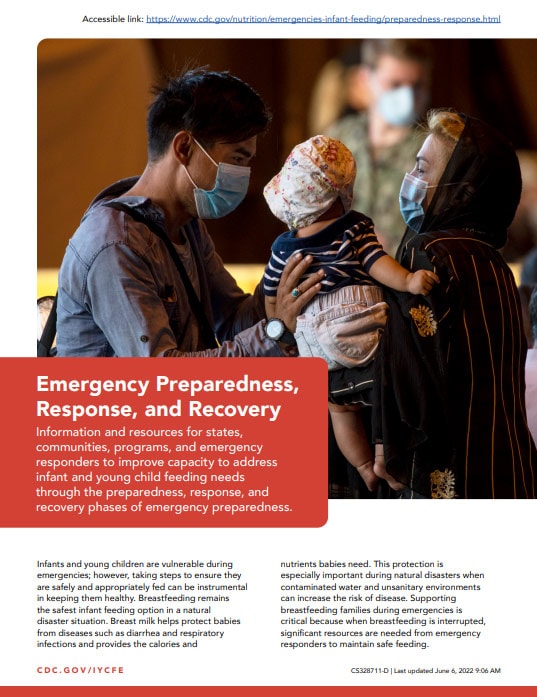Emergency Preparedness, Response, and Recovery
Information and resources for states, communities, programs, and emergency responders to improve capacity to address infant and young child feeding needs through the preparedness, response, and recovery phases of emergency preparedness.
Infants and young children are vulnerable during emergencies; however, taking steps to ensure they are safely and appropriately fed can be instrumental in keeping them healthy. Breastfeeding remains the safest infant feeding option in a natural disaster situation. Breast milk helps protect babies from diseases such as diarrhea and respiratory infections and provides the calories and nutrients babies need. This protection is especially important during natural disasters when contaminated water and unsanitary environments can increase the risk of disease. Supporting breastfeeding families during emergencies is critical because when breastfeeding is interrupted, significant resources are needed from emergency responders to maintain safe feeding.
Infants are fed in a variety of ways, all of which need to be considered when planning for and responding to an emergency. Some infants may be exclusively breastfed, while others may be receiving both breast milk and infant formula, or only infant formula. Other infants may receive expressed breast milk, but not feed directly at the breast. Some infants require specialized infant formulas and enteral tube feeds (e.g., nasogastric tube, G-tube) or total parenteral nutrition (TPN) which requires specialized knowledge, equipment, and a power source. After the age of about 6 months, infants are also eating solid foods in addition to breast milk or infant formula and over time, young children will transition to more solid foods and other liquids.
Parents and caregivers of formula fed infants may not have access to safe water, electricity, gas, or cleaning supplies during an emergency, impacting their ability to safely prepare infant formula or clean infant feeding items, such as bottles, nipples, utensils, and plates. These challenges increase the risk of serious illness for infants who are fed infant formula during emergencies.
Infant and young child feeding information should be coordinated and integrated into emergency preparedness and response efforts for all maternal and child health populations. The following sections on preparedness, response, and recovery provide information and resources for how to best address the range of infant feeding practices throughout each of these phases.
The Dietary Guidelines for Americans 2020-2025 recommend that infants be exclusively breastfed for about 6 months and then continuing breastfeeding while introducing solid foods for 1 year or longer.
The American Academy of Pediatrics and the World Health Organization also recommend exclusive breastfeeding for about the first 6 months of age with continued breastfeeding along with appropriate solid foods for up to 2 years of age or longer.
Breastfeeding can help protect both mom and baby against some short- and long-term illnesses and diseases.

